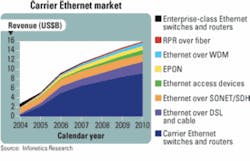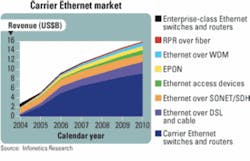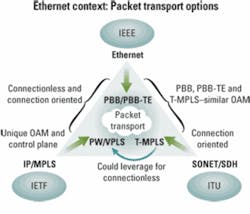Carrier Ethernet nears MAN/WAN tipping point
by John Sauer
Given Ethernet’s proven track record, it comes as no surprise that enterprise customers want to take the traditional benefits of Ethernet in the LAN-speed, scalability, simplicity, and bandwidth-on-demand flexibility-and extend them into the MAN and WAN. Naturally, they still want the carrier-grade service they have come to expect from MANs and WANs, and they want all of these best-of-both-worlds capabilities at an affordable price.The growing demand for Ethernet across the MAN and the WAN, also known as “Carrier Ethernet,” presents a tremendous opportunity for service providers. But to seize that opportunity, they must beef up their transport networks to deliver MAN and WAN Ethernet services reliably, cost-effectively, and in ways that scale readily.
Before examining the transport-network challenges confronting service providers, it is important to sort through current confusion in the market about what exactly Carrier Ethernet is and whether it is viable today. For example, many people in the industry talk about “Ethernet,” while others use the term “Ethernet service.” There is a difference.
Today, the term “Ethernet” refers to an interconnect technology standardized by the Institute of Electrical and Electronics Engineers (IEEE). Basically, Ethernet is a collection of frame-based LAN physical and signaling standards, with a broad range of transmission speeds supporting copper and optical-fiber interconnects. The Ethernet standard, which specifies a media access control (MAC) and data link layer with addressing and common frame format, is expanding rapidly to provide more carrier-grade capabilities.
The term “Ethernet service” refers to a “black box” or carrier-service interface presented to the customer. From the customer’s perspective, Ethernet service looks like a historic LAN interface with some operations, administration, and maintenance (OA&M) extensions. However, various underlying technologies such as native Ethernet, Ethernet over SONET/SDH, Internet Protocol (IP), multiprotocol label switching (MPLS), or combinations thereof, may carry Ethernet service, and the service provider can extend Ethernet service across the MAN and WAN. Typically, an enterprise uses this Ethernet service to carry IP, just as it does in the LAN.A service provider can use Ethernet interconnect to provide other types of services, such as IPTV. In that example, the Ethernet interconnect links the IPTV nodes-servers, clients, etc.-that are part of the IPTV service. Note that a service provider can offer a separate Ethernet service to an IPTV customer as well, which may require additional Ethernet interconnects.
Historically, service providers and enterprises used different technologies to build their respective networks. Service providers have relied primarily on time-division multiplexing (TDM) equipment, which is based on 64-kbit/sec increments, as in the voice network. They also have used Frame Relay and Asynchronous Transfer Mode technologies that, although reliable, require complex and expensive set-up procedures and protocol conversions. Enterprises, by contrast, have used mostly Ethernet technology, which is based on powers-of-10 increments, for example, 100 Mbits/sec, 1 Gbit/sec, and 10 Gbits/sec.
Typically, the low interface speeds of TDM-based services, relative to those of Ethernet-based services, mean that if a customer wants anything faster than a T1/E1 (1.544/2.048 Mbits/sec) interface, it costs the service provider significantly more to deliver the faster service. In addition to speed and cost, there is the issue of flexibility-or lack thereof. Because a bottleneck forms where the enterprise and service-provider networks meet, businesses with their Ethernet-connected offices basically must squeeze their Ethernet traffic into fixed-size TDM circuits.
Service providers today also face some transmission-related challenges in their transport networks. First, in terms of router-to-router interconnects, the bit rates of 10-Gbit/sec SONET/SDH interfaces do not quite match those of today’s 10-Gbit/sec Ethernet LAN interfaces. The former are a little too slow, and that obviously causes problems. As service providers move above 10-Gbit/sec to 40-Gbit/sec and eventually 100-Gbit/sec interfaces, they are moving into the Ethernet world. Over time, higher bit rates will limit the role of traditional SONET/SDH interfaces.
A second transmission-related challenge confronting service providers is the fact that they have made significant investments in high-speed SONET/SDH networks. Because many of those networks are not filled to capacity, economic reality dictates that they will be around for quite some time. Of course, if a given service provider already is running OC-48/STM-16 links that are at or near capacity, that provider is more likely to cap SONET/SDH investments at OC-48/STM-16 and transition the network to Ethernet.
For each service provider, the timing of that transition will depend on two questions. First, is the SONET/SDH network already filled with reasonably sized pipes, such as OC-48s or OC-192s? Second, how long will it take to depreciate that SONET/SDH network? The answer to both questions will determine whether the next interface an individual service provider buys is a 10-Gigabit Ethernet interface or an OC-192 interface.
By now, it is a given that the telecommunications industry is migrating to a packet-based infrastructure; it is not a matter of if but when. As mentioned earlier, service providers can use native Ethernet, Ethernet over SONET/SDH, IP, and/or MPLS to provide Ethernet service. The choice depends in large part on the individual service provider’s business strategy and the specific requirements of the enterprise customer in question.
For example, with today’s technology, a service provider who wants to offer Carrier Ethernet service-that is, the Ethernet interface to the customer-with guaranteed quality of service (QoS) likely will use MPLS pseudowires as the underlying technology. Others may use Ethernet over SONET/SDH, and still others may deploy native Ethernet switches.
Despite the existence of that technology mix, a hybrid concept appears to be winning favor throughout the industry, as many service providers attempt to leverage the best of pseudowire and native Ethernet technologies. Because of the perceived simplicity and economics of native Ethernet access, many service providers are using it to deal with the edges-where all the MAC addresses lie-and then present a simpler picture to the center of the network, by using that native Ethernet access to feed an MPLS core. They typically use stacked VLAN tags, also known as “Q-in-Q,” to feed an MPLS-based virtual private LAN service (VPLS) core.
Additional efforts are underway to apply traffic engineering and virtual circuit management methods for the carriage of Ethernet; the IETF has developed the use of MPLS pseudowires, the ITU has standardized Transport MPLS (T-MPLS), and the IEEE is extending MAC-in-MAC methods to include Traffic Engineering with Provider Backbone Bridging extensions (PBB-TE). All of these methods address the need for traffic engineered packet transport.
Even within a single service provider’s network, it is not unusual to find Ethernet services based on a variety of approaches, including native Ethernet. Although native Ethernet is based on Ethernet switches, today such a pure-Ethernet infrastructure can natively support multipoint connections. Service providers regard this capability as a long-term advantage, simply because they do not have to support a multipoint network over a non-native multipoint architecture.
Currently, the sum of all these evolutionary efforts in the industry is a network made up of an Ethernet cloud on the left, an Ethernet cloud on the right and, in the middle, SONET/SDH. At the same time, the industry is moving gradually to a scenario where, in many cases, MPLS pseudowires replace SONET/SDH in the middle. Eventually, the ongoing evolution of the transport network may culminate in an all-Ethernet scenario.
While that scenario is a possibility, it is important to note that the industry’s long-term goal is to provide Carrier Ethernet service at the lowest possible cost, regardless of the underlying technology. At the moment, standards-setting bodies, service providers, and vendors are trying to evolve native Ethernet to meet this goal, but the market will decide whether that is the best approach.
Even if the market were to decide in favor of native Ethernet, it is unlikely that native Ethernet will extend all the way into the center of the core. After all, because the industry’s ultimate goal is to provide IP-based services, many routers will continue to exist and function in the network. Therefore, in the long run service providers probably will maintain an IP mixture with an MPLS core, but they certainly will surround it with an Ethernet infrastructure, a deployment scenario that will extend the concepts of hierarchical VPLS. Although a hybrid approach is the most likely near-term scenario, scalability requirements eventually will require a MAC-in-MAC (PBB) approach to blend with-and perhaps even supplant-the stacked VLAN tag method.
Service providers clearly are enhancing the capabilities of their transport networks to offer Carrier Ethernet service. Yet that begs the question, is Carrier Ethernet today ready to replace services based on TDM and SONET/SDH technologies? The answer is that Carrier Ethernet service is not quite here, but it is definitely coming.
As noted earlier, service providers are offering Carrier Ethernet service today, mainly by using MPLS pseudowires where QoS requirements apply and by using native Ethernet elsewhere. Nevertheless, Carrier Ethernet service, be it the native Ethernet version or a non-native version, is not quite ready to fully replace services based on TDM and SONET/SDH. However, it is important to note that the industry is working in standards-setting bodies, and it is just a matter of time before it solves those issues.
Currently, the limitations of non-native Ethernet versions have to do primarily with the Ethernet network-to-network interface (NNI) and OA&M. The Ethernet NNI standard is in its infancy, and obviously without a standard NNI, there can be no true Carrier Ethernet service. Although service providers today certainly can deploy Carrier Ethernet service, such services are not ubiquitous. Consequently, defining the Ethernet NNI is high on the Metro Ethernet Forum’s (MEF’s) agenda.
Similarly, the industry is working diligently to define the OA&M standard, which still is not adequate for end-to-end Ethernet service, relative to the TDM standards. The basic challenges center on determining how to detect and troubleshoot problems. With multiple carriers providing end-to-end Carrier Ethernet service, it is extremely difficult, absent an OA&M standard, to determine which network is the site of a specific problem.
Prompted by growing enterprise demand for Carrier Ethernet service and by service providers’ eagerness to seize the market opportunities presented by that demand, three major industry groups are working hard to expand and strengthen native Ethernet.
As mentioned above, the MEF is focusing much of its efforts on defining an Ethernet NNI. The IEEE 802.1ag committee is working on Ethernet OA&M, specifically to:
• Standardize connectivity fault management.
• Define maintenance domains and the relationship between them and the services provided by VLAN-aware bridges and provider bridges.
• Define protocols and procedures used by maintenance points to maintain and diagnose connectivity faults within a maintenance domain.
The committee expects to issue its recommendation soon. The International Telecommunications Union (ITU) also is working to strengthen evolving OA&M standards, primarily by defining performance enhancements.
Carrier Ethernet service is an evolving concept, one that is still very much in its early days but one that also is maturing rapidly. Undoubtedly the industry will resolve the current issues and bring Carrier Ethernet service to a tipping point. When improved Ethernet-service OA&M and NNI definitions are in place, they will persuade the vast majority of enterprise customers that it is possible to write-and enforce-Ethernet carrier-grade service-level agreements. At that point, Carrier Ethernet will likely become the de facto choice for satisfying MAN and WAN service requirements.
John Sauer is senior principal engineer at Tellabs’ (www.tellabs.com) Global Marketing Group. In this role, he is responsible for network evolution, with a concentration on Carrier Ethernet. Sauer has more than 20 years of technical and strategy management experience in the computer and communications industry.


